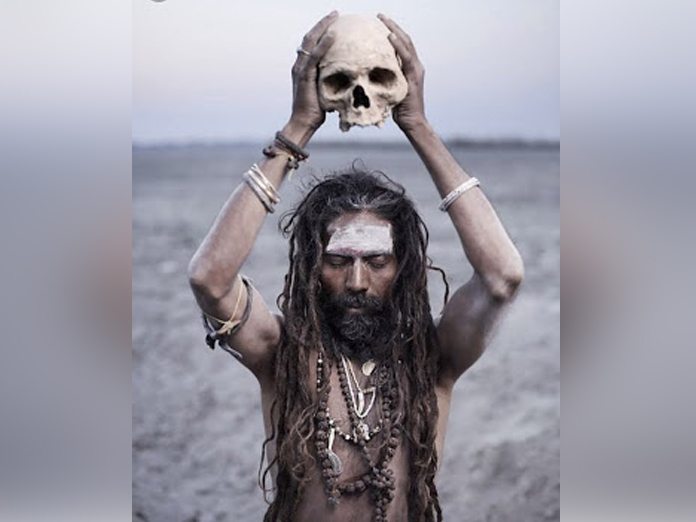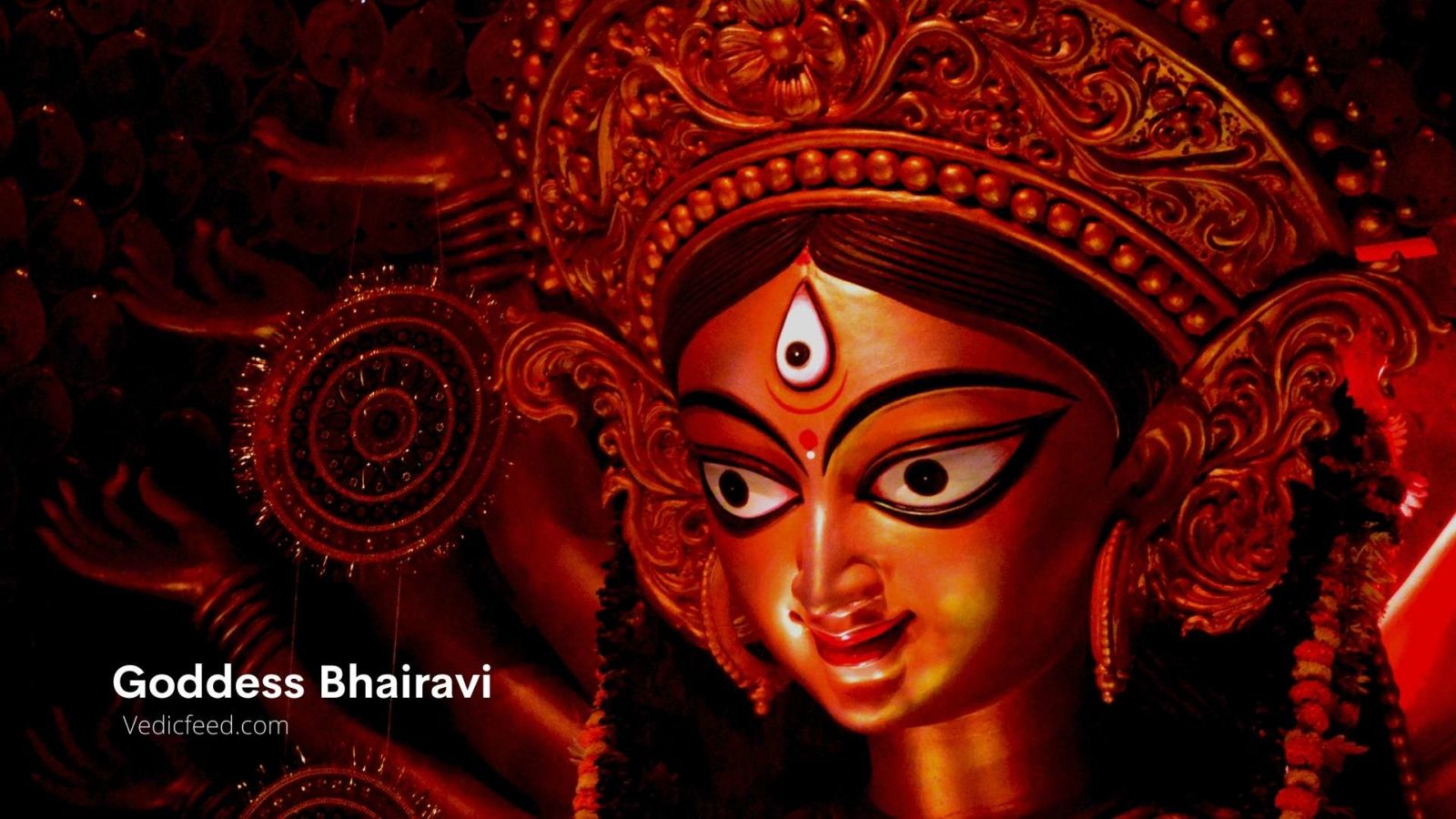No products in the cart.
Devi Bhairavi, the fifth of the Mahavidyas, is the goddess of creation, preservation, and destruction. The name Bhairavi means “terrible,” “terrible,” “terrible,” or “terrible.” Devi Bhairavi is an angry goddess whose name brings terror to all three worlds.
Bhairavi is responsible for creating what is followed by destruction. Also known as Tripura Bhairavi, associated with three lokas or three worlds.
It contains features of Agni (Fire), Vidyut (lightning), and Surya (Sun), which includes gods such as Indra, Surya, and Agni. She is the goddess of Kundalini, the supernatural power found at the base of the spine. This is also why the worship of Devi Bhairavi almost always contains meditation that will help awaken Kundalini.
The inner meaning of the name Bhairavi mamba is  the cosmic works of creation, care, and destruction. The goddess Bhairavi represents the ever-changing heat, ‘Tapas’, and the Divine Light, ‘Tejas’. Tapas is not just a self-denial, a growing desire that consumes every second interest and attachment. Bhairavi is a revolution that comes with destruction, which is not a bad truth. He made human light and heat that could burn imperfection in the soul.
the cosmic works of creation, care, and destruction. The goddess Bhairavi represents the ever-changing heat, ‘Tapas’, and the Divine Light, ‘Tejas’. Tapas is not just a self-denial, a growing desire that consumes every second interest and attachment. Bhairavi is a revolution that comes with destruction, which is not a bad truth. He made human light and heat that could burn imperfection in the soul.
The goddess Bhairavi is a person born of the goddess Shakti and is a deity known for her Hindu folklore and among tantric practices. He is the ‘heroic goddess,’ who by His power of divine expression and spiritual fire removes all obstacles to the revelation of true consciousness, just as He destroyed the demon Mahishasura.
The goddess Bhairavi conspired to destroy the system. She is regarded as the queen of Bhairava, the fierce kind of king Shiva and the ever-present goddess who combines the destructive elements of the world. Destruction is not always bad, nature cannot continue without it. She is also known as Shubmkari, a Good Mother to Good People. Then it is bad for bad people.
It is believed that when the goddess Bhairavi entered the battlefield, her horrible appearance made the demons very weak and very weak, and many demons began to panic as soon as they saw her. In Durga Saptashat’s version of the killing of powerful demons Shumbha and Nishumbha, the goddess Bhairavi is seen mainly as the goddess Kali. The goddess Parvati gave him the blessing of being named Chamundeshwari when he killed and drank Chanda and Munda’s blood.
CREATION AND BAPTISM are two essential elements of the universe, which remain subject to their ever-changing rhythm. They both rule equally in the world and depend on each other in a symbiotic way. Bhairavi includes the goal of destruction. He appears or is present when the body descends and decays, which is a natural force, unavoidable, and unavoidable. Bhairavi is also seen in self-harming habits, such as eating tammic food (food that is associated with ignorance and lust) and drinking alcohol, which causes body and mind.
He is said to be losing semen, which makes men weaker. Anger, jealousy, and other feelings and selfish actions reinforce Bhairavi’s presence in the world. Right behavior, in contrast, makes him weak. In short, she is an eternal goddess who reveals herself, and symbolizes the destructive elements of the world. Destruction, however, is not always bad, nature cannot continue without it. This is especially evident in the diet and metabolism, where life is often fatal; creation continues with the transformed power devoted to destruction.
Origin of Goddess Bhairavi
The goddess of destruction is the mistress of Kala Bhairava, the fierce kind of King Shiva and hence she is also known as Kala Bhairavi. The goddess Kali is known as the first form of power (Adi Shakti). He is worshiped in ten different forms known as Dasa Mahavidyas, the fifth of which is Bhairavi. That is why he also shared so many features with Goddess Kali.

Devi Bhairavi praises the great power of speech, empowered by the wrath of the blazing fire, the Tejas.
Her fierce appearance
The goddess Bhairavi is often portrayed in the crematorium as a form of sadhana. Her hair, unlike other goddesses, is not neatly tied, it is full on her head. She is wearing a red dress adorned with a skull, like the Goddess Kali.
His one hand is shown, giving us an advantage and telling us not to show fear. On one side, he is holding a sword, and on the other, he is holding a headless body. She has reddish-brown skin and blood smeared on her body. He is shown carrying weapons such as trident and heaven.
The goddess Bhairavi is often portrayed as sitting on a headless body called Savasadhana, which is also a form of meditation. His two hands are in Abhaya and Varada mudras. His Vahana is a lion that demonstrates his power on the battlefield. He is portrayed as happy or in a bad mood with teeth.
He lives in the area of the patal (land below). She is an incomprehensible goddess, calm and well-mannered, while meditating on the beheaded corpse shows us how she is contained. In some species, she is depicted as a blood-drinking goddess covered with leopard skin and skeleton.
In the battlefield
One does not want to be on the edge of one’s anger. His appearance caused the demons to kneel only on their knees. The existence of bhairavi is symbolic even in today’s world. He is said to be present in all our harmful habits, desires, and thoughts, and he helps us to fight them. He also illustrates the power of knowledge.
Bhairavi in Tantra Vidhya
It is a form of great cosmic awareness and is considered one of the most powerful Tantric goddesses among Das Mahavidhya. She is a mother who can do almost anything to protect her children.
In Tantra Vidhya, you are an immature form of power. It is associated with many tantric kriyas such as bhairavi kriya. Those who make up these kriyas combine all forms of light energy, fire, and earth into one. It also has the power to regulate rebirth and human migration in three different countries.
Chatuhsasthi Yogini
It refers to 64 Yoginis. This was a mysterious women’s cult of the 9th century. The purpose of this program was to develop supernatural powers. They considered themselves servants of the Divine Mother. They were naturally devoted. They are said to have supernatural abilities. These yoghurts are linked to black tanrism but that doesn’t make them witches! Their theme of worship was Bhairavi, Kali and Shiva Bhairava. They used the destructive power of Kali or Bhairavi with the intention of reaching a good conclusion.

There is an ancient Yogini temple in Hirapur. Here, the chief Yogini goddess was Mahamaya, as Devi Bhagavatam used. The difference between Kali and Bhairavi is that King Shiva is very angry as Bhairavi’s wife but his anger does not seem so great as Kali’s friend. It therefore brings to mind the fact that Bhairavi is the most cruel form of the Divine Mother.
Kaula Marga or Path of Time practice points to tantric practices associated with the worship of the goddess. Bhairavi is aware of his angry state in a practice known as the Bhairava Chakra. Yogins of various categories are included in the chakra or circle of experience. The sadhana or tradition includes 5 M’s: Matsys – bowl, Mamsa – meat, Mudra – milled grain, Madya – alcoholic beverage and Maithuna – sex. Maithuna or sexual reference in Tantra may be a physical act or secret code, that information should be sought from the guru.
AGHORIS
AGHORIS pays homage to Birava and Birairavi in the temples of Siva. They are also found near smoking cemeteries. They stand as the angry species of Shiva and her friend Parvati represented by a stone with an angry face painted on it, and a  wooden trunk painted with three eyes of a goddess. In front of their temple are three skulls, representing Shiva’s reign over three guns. In front of the truck is a female fox, which serves as a ‘messenger’ or messenger of Smashan Tara – ‘Tara Cemetery’. Behind the jackal is an angry lamp made of a human skull turned. The skull rests on a square block of land, and it is driven by human fat and twisted hair. In the flames of this lamp appears the symbol of the tantric rod or khatvanga, made of a small skull placed over the handle of a human vertebrae. At the top of this skull-staff frame is a fiery metal trident, symbolizing the goddess victory over the three kingdoms, below, above, and above the earth, three times past, present and future, as well as three toxins, ignorance, desire and hatred. .
wooden trunk painted with three eyes of a goddess. In front of their temple are three skulls, representing Shiva’s reign over three guns. In front of the truck is a female fox, which serves as a ‘messenger’ or messenger of Smashan Tara – ‘Tara Cemetery’. Behind the jackal is an angry lamp made of a human skull turned. The skull rests on a square block of land, and it is driven by human fat and twisted hair. In the flames of this lamp appears the symbol of the tantric rod or khatvanga, made of a small skull placed over the handle of a human vertebrae. At the top of this skull-staff frame is a fiery metal trident, symbolizing the goddess victory over the three kingdoms, below, above, and above the earth, three times past, present and future, as well as three toxins, ignorance, desire and hatred. .
Goddesses are revered as just love. Bhairavi has his own customs and those who have not been given a tantra may have focused on gentle goddesses. However Goddesses are goddesses. There is a big difference between a fire from a matchbox and a forest fire.
Worship of Goddess Bhairavi
She is worshiped as a chakra with 64 speakers on the wheel. The worship of ten mahavidyas gives an immediate blessing, and one is blessed with a child. He helps his worshipers find relief from the pain and suffering of loss and bereavement.
Sadhak (worshiper) who completes the bhairavi sadhana acquires all the Ashtarsids, which leads to spiritual progress in understanding all supernatural powers and techniques. He protects us from all bad influences.

She is a goddess who is feared by all evildoers and good. Though frightening, his only purpose is to continue the cycle of destruction and creation on earth. She is a loving mother with all her children and can go to any lengths to protect her lover. The famous deity of Tantra Vidhya, the goddess Bhairavi holds a special place in all forms of worship.3382
Unlike the Trinity god Brahma, Vishnu, and Shiva, who controls the one kind of life and the creation of the world, the preservation, and destruction, the goddess bairavi controls all three aspects of life. She is a vicious kind of goddess, but she has a great, remarkable knowledge. He expels the evil forces that try to hinder spiritual growth.







